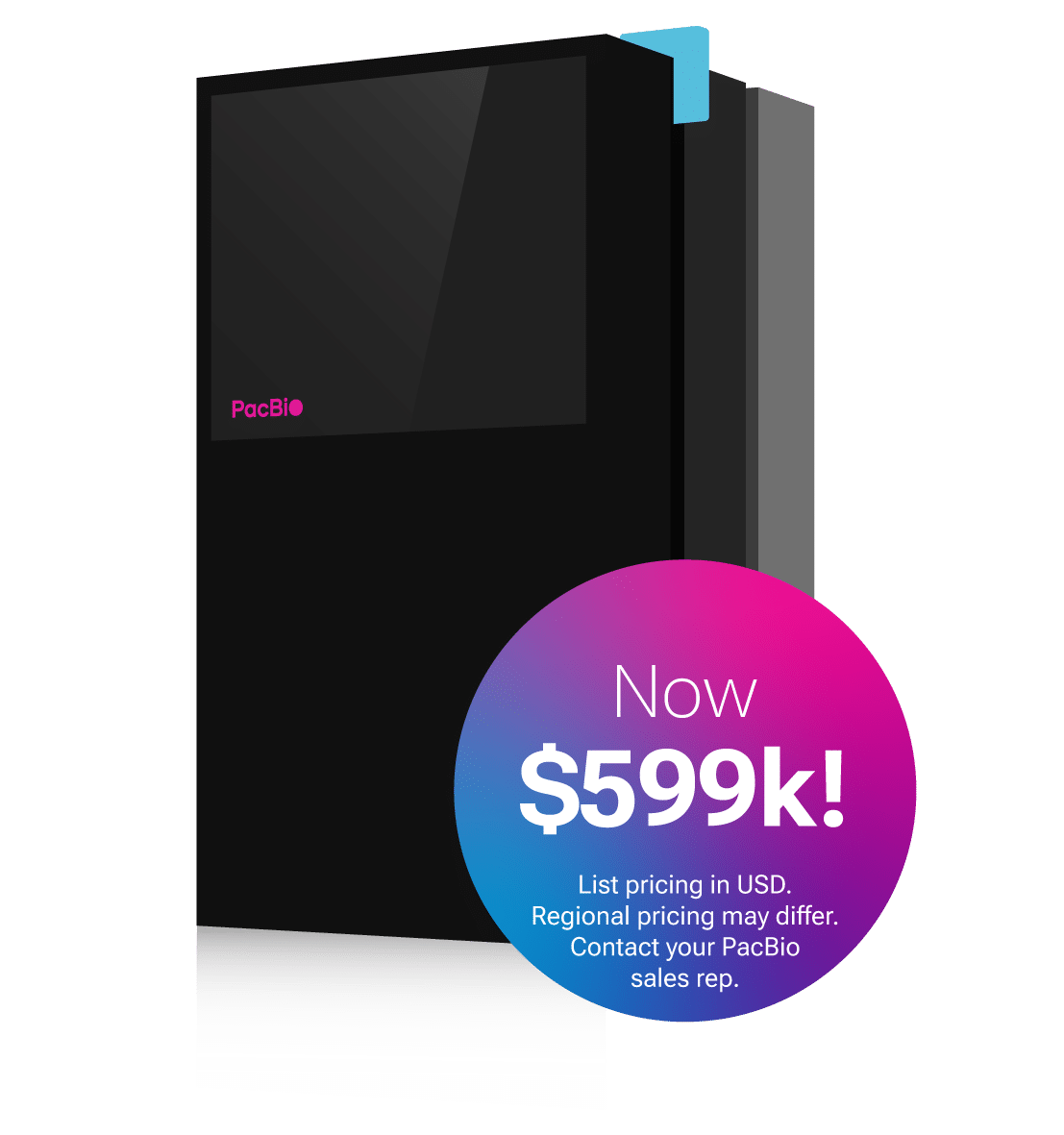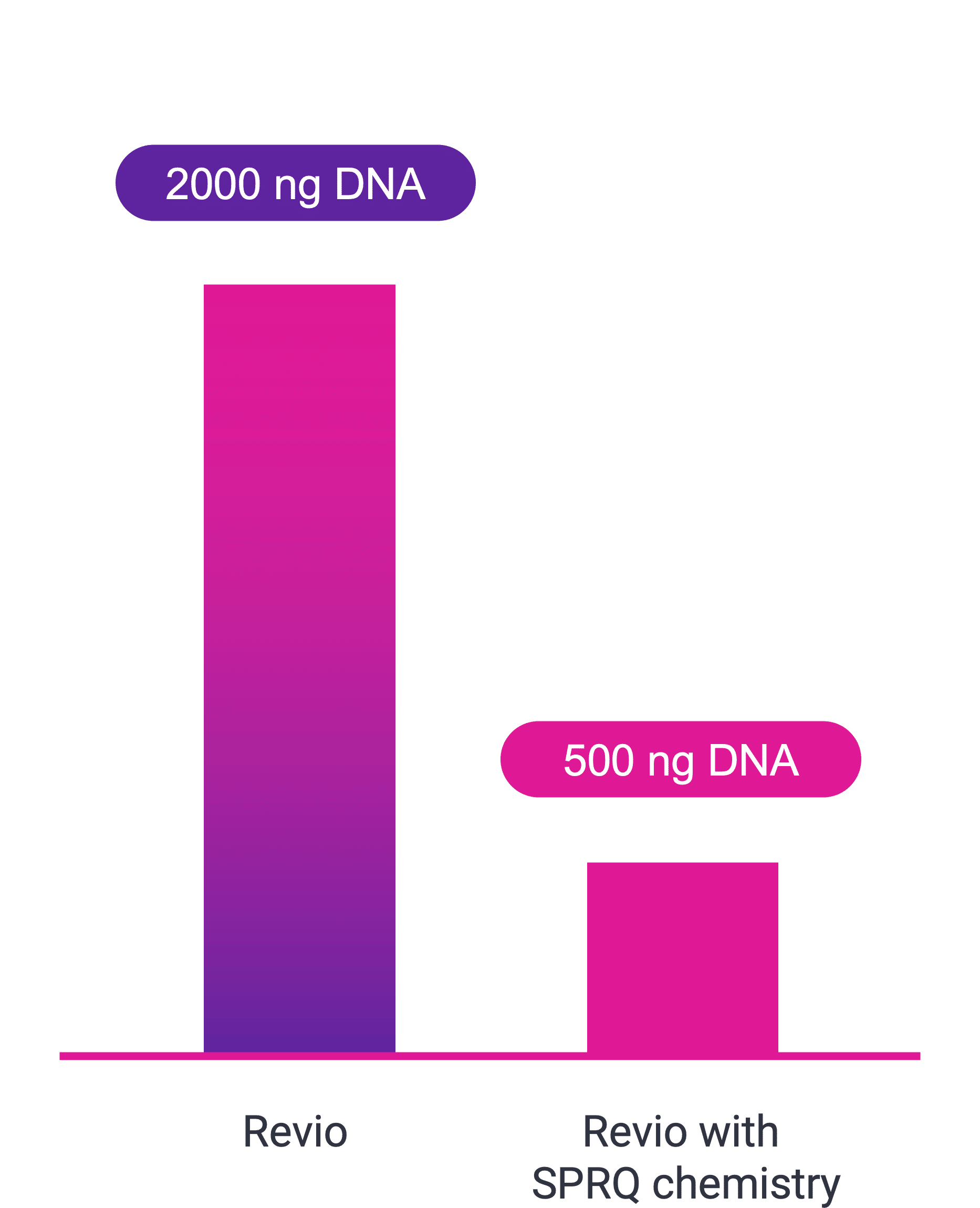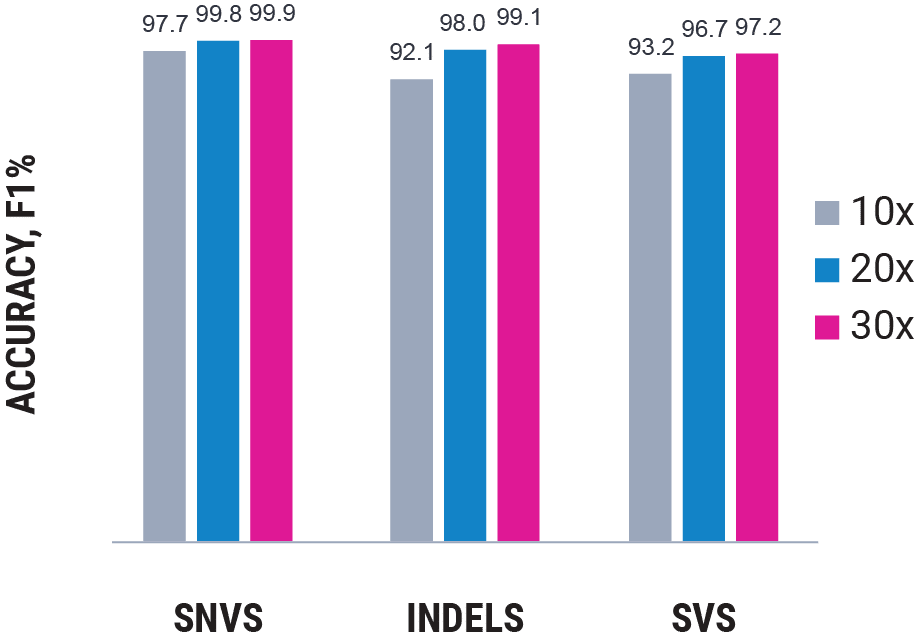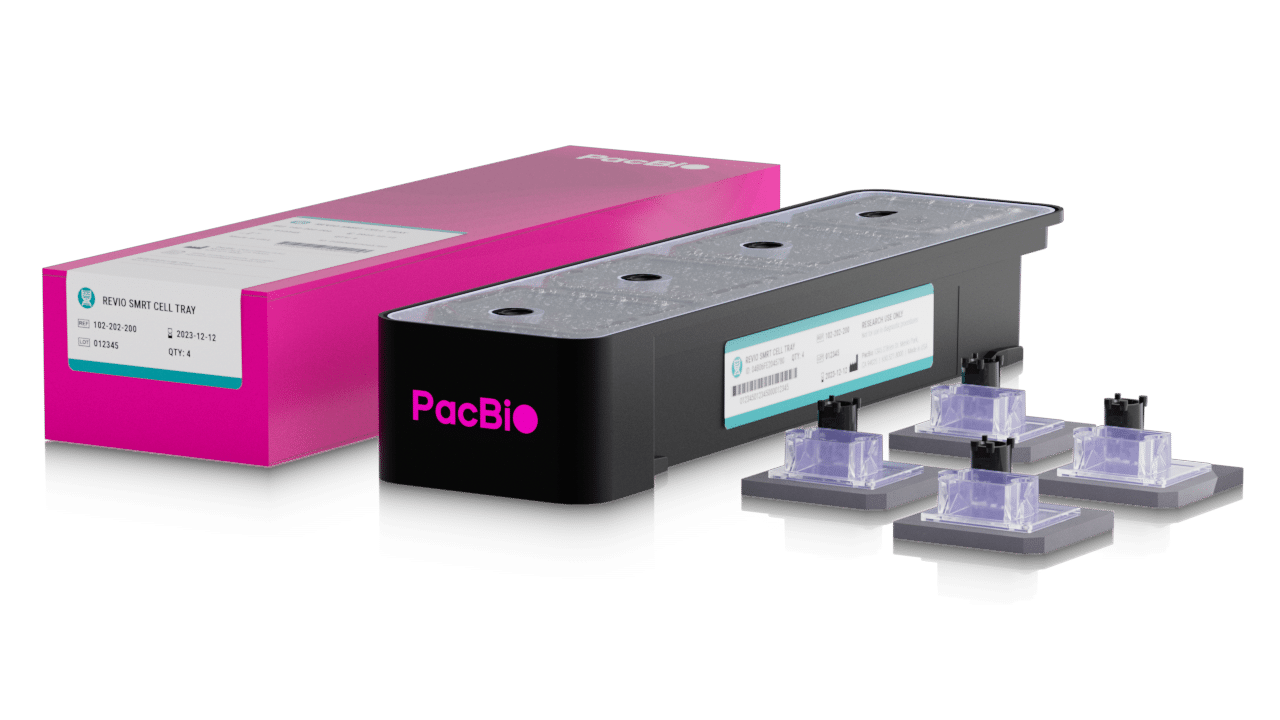HiFi sequencing at scale
With a high-density SMRT Cell, up to 4 SMRT Cells per run, and 24-hour run times3, the Revio system with SPRQ chemistry delivers up to 480 Gb2,5 of HiFi reads per day, equivalent to 2,500 human whole genomes4 per year.
The $5006 complete, phased genome
HiFi sequencing provides small variants, structural variants, repeat expansions, methylation, and haplotype phasing from a single library and sequencing run. With a comprehensive genome, you can replace multiple assays, saving valuable time and resources while gaining deeper insights in one streamlined process.
Long-read genomes at scale, with 4x less DNA input required
SPRQ chemistry on the Revio system unlocks the ability to sequence more sample types than ever before, using just 500 ng of native DNA – without sacrificing the high throughput or exceptional quality you rely on.
On-instrument 5mC and 6mA caller for multiomic Fiber-seq chromatin assay
SPRQ chemistry, paired with Google Health DeepConsensus algorithms, delivers exceptional read accuracy plus confident 5mC and 6mA methylation detection in every run. Optimized file formats reduce data storage needs through quality value binning and smart read ordering, streamlining data handling and maximizing efficiency.

HiFi sequencing at scale

Estonia National Biobank selects PacBio to sequence 10,000 whole genomes
HiFi data generated on the Revio system will support the EU and Estonian government-funded Center for Personalized Medicine to enable discoveries across cardiology, mental and reproductive health, drug response, cancer research and rare diseases.
Ignite your research with SPRQ chemistry
With SPRQ chemistry, the Revio system helps you achieve more with less DNA, increasing efficiency, maximizing output, and reducing costs – empowering you to make more discoveries faster and affordably.
Reduced input, expanded application possibilities:
- Only 500 ng DNA input
- 4X more efficient SMRT Cell loading
Drive down genome costs:
- 33% increased HiFi yields
- 2 human genomes at 20X per SMRT Cell
Spark innovation:
Resolve chromatin architecture with Fiber-seq powered by on-instrument 5mC and 6mA calling, now with an increased 5mC CpG accuracy for even greater precision.
Key applications and sample throughput with SPRQ chemistry
“HiFi long read sequencing can now produce the most comprehensive variant dataset obtainable by a single technology in a single laboratory, allowing accurate calling of substitutions, indels, STRs and SVs.”
– Kucuk et al., Genome Med, 2023
HIFI LEVEL ACCURACY AND DATA QUALITY
The Revio system with SPRQ chemistry produces exceptional read length, quality, and variant calling performance that have made HiFi sequencing so celebrated.
Reveal a more complete genome
The complete, gapless human genome marks a new era of genomics where no region of the genome is beyond your reach. In 2021, PacBio HiFi technology was used by the Telomere-to- Telomere (T2T) Consortium to fill in those gaps.
Read length
HiFi reads are tens of kilobases long, providing the ability to resolve large variants and map to difficult regions of the genome.
Read and base quality
The Revio system provides reliable answers through exceptional accuracy, with 90% of bases Q30+ and median read accuracy ≥Q30.
Variant calling
HiFi sequencing with SPRQ chemistry on the Revio system delivers high accuracy variant detection, resulting in fewer sequencing errors relative to other technologies at lower coverage1.
How Revio long-read sequencing compares
| PacBio Revio with SPRQ | SBS sequencing | Nanopore sequencing | |
|---|---|---|---|
| Read length |
15-20 kb5 |
2x150 bp | 10–100 kb |
| Read accuracy |
99.95% (Q33)1 |
99.92% (Q31)3 |
98.90% (Q19)4 |
| Run time |
24 hours2 |
44 hours | 72 hours |
| Yield |
120 - 480 Gb2 |
2,400–3,000 Gb | 50–110 Gb |
| Coverage | Unbiased | Reduced at low and high (GC) | Reduced in low-complexity runs |
|
Genome completeness6 |
✓ |
X |
✓ |
|
Variant calling – SNVs, Indels, SVs5 |
✓ |
X |
X |
| Areas of high homology |
✓ |
X |
X |
| Phasing |
✓ |
X |
✓ |
| Methylation - 5mC and 6mA | Every run | Via library prep | Every run |
|
1. Read accuracy PacBio HiFi: precisionFDA Truth Challenge V2 3. Illumina: HG002 2×150 bp NovaSeq library, precisionFDA Truth Challenge V2 |
|||
Workflow
Extraction
Nanobind DNA kits enable extraction of HMW gDNA from a variety of samples: saliva, cultured cells, bacteria, whole blood, tissue, plant nuclei, and insect.
Library prep
SMRTbell prep kit 3.0, HiFi prep kits, and application kits (Kinnex, PureTarget) support manual and automated library prep for effortless SMRTbell library creation.
Sequencing
The Revio system offers simultaneous acquisition of 4 SMRT Cells, configurable sequencing run times to tailor to your application, and flexible run scheduling to fit your schedule.
Data analysis
Advanced algorithms from Google Health and cutting-edge NVIDIA GPUs allow for on-board processing of sequencing data, all with reduced output file sizes.
Simplified Consumables
The Revio system simplifies the HiFi sequencing experience with fewer consumables optimized for easy tracking and minimal waste. With workflow improvements, loading consumables takes under a minute at the instrument.
Revio SMRT Cell tray
One tray contains 4 high-density SMRT Cells.
Revio SPRQ sequencing plate
The sequencing plate provides reagents for sequencing up to 4 Revio SMRT Cells.
A WORKFLOW BUILT FOR YOUR SCHEDULE
The Revio system gives you a vastly simplified experience with consumables and software designed for flexibility and convenience. Whether you’re a genome center or a small lab, you can enjoy:
Fast, reliable library preparation
Library prep for the Revio system supports manual and automated prep. Learn more
Rapid run setup
Sequencing plates are linked automatically to run designs through an NFC tag, enabling runs to be set up in less than one minute on instrument.
Flexibility to fit your schedule
The Revio work deck is isolated from the four sequencing stages, leaving the system available up to 20 hours per day for loading consumables for subsequent runs.
MASSIVE COMPUTE POWER
The Revio system includes powerful NVIDIA GPUs, which provide more than 20× the compute power of the Sequel IIe system, to deliver accurate, ready-to-use data directly from the instrument.
HiFi read generation
The GPUs provide rapid turnaround time for basecalling and HiFi read generation, directly outputting HiFi reads in BAM format.
Google Health DeepConsensus
DeepConsensus uses advanced deep learning techniques to further extend the accuracy and yield of HiFi sequencing.
Methylation calling (5mC and 6mA)
Standard runs include DNA methylation status, calculated with a deep learning algorithm that processes polymerase kinetics.
Demultiplexing
All fundamental processing steps are performed on instrument, including barcode demultiplexing.

More HiFi reads, more samples, more discovery
System specifications with SPRQ chemistry
The Revio system utilizes nanofabricated Revio SMRT Cells and has four independent stages, allowing sequencing of multiple SMRT Cells in parallel. The onboard compute provides accurate basecalling with Google DeepConsensus, plus methylation calling in every run.
| Library |
Run timea |
Q30+ bases |
HiFi yield per SMRT Cellb |
Methylation | ||||
|---|---|---|---|---|---|---|---|---|
| 0.5-5 kb | 12 hours | 95% | 6-8 million reads | 5mC at CpG sites and 6mA for native DNAc | ||||
| 5-10 kb | 24 hours | 90% | 35-70 Gb | |||||
| 10-15 kb | 70-100 Gb | |||||||
| 15-20 kb | 100-120 Gb | |||||||
| 20-25 kb | 30 hours | 85% | 100-120 Gb | |||||
|
||||||||
Instrument specifications
| Operating environment | |
| Temperature | 19–25°C (66–77°F) |
| Humidity | 20–80% relative humidity, non-condensing |
| Ventilation | 13,000 BTU/hr (3,800 W) |
| Dimensions | |
| W × D × H | 92.7 cm (36.5 in) × 91.4 cm (36.0 in) × 174.5 cm (68.7 in) |
| Weight | 465 kg (1,025 lb) |
| Floor space | 243.8 cm (96.0 in) × 138.5 cm (54.5 in) |
| Electrical power | |
| Power requirements | 200–240 VAC at 50-60 Hz, max 5 kVA/4.8 kW/24A |
| Compute | |
| Network connection | 1 GbE or 10 GbE, copper |
| Output file format | hifi_reads.bam, ~60 GB each, up to 78 TB per year |
Frequently asked questions
The SPRQ (pronounced “spark”) chemistry is our newest HiFi chemistry that makes sequencing more efficient and expands HiFi sequencing to more sample types and applications. SPRQ requires only 500 ng of native DNA, which opens up even more possibilities for your projects. Plus, SPRQ helps lower genome costs by increasing HiFi yields per SMRT Cell by 33%, allowing you to sequence two human genomes at 20X coverage per SMRT Cell.
And that’s not all—SPRQ also enables deeper multiomic insights into chromatin architecture with Fiber-seq, using on-instrument 5mC and 6mA calling for greater precision in methylation detection.
The Revio system with SPRQ chemistry sequences two human genomes at 20x coverage for just $5006. Your local sales representative can provide detailed pricing in your currency.
The capabilities† of just one Revio SMRT Cell include:
- Up to 120 Gb of total HiFi long-read sequencing data in 24 hours.
- Two phased 20x human whole genome.
- One sample with ~80 million full-length RNA isoforms using the Kinnex single-cell RNA kit.
- 16 samples using large, targeted gene panels such as the Dark Gene.
- 96 samples using small, targeted gene panels similar to the Long-read PGx.
- 16 communities of metagenome assembled genomes.
† Expected coverage and throughput are estimates. Coverage and total reads/data may vary based on library quality and fragment lengths.
The Revio system outputs ready-to-use HiFi reads in BAM format. All fundamental processing steps are performed on instrument, including barcode demultiplexing.
- Data shown is for a single Revio SMRT Cell for HG002/GM24385.
- HiFi yield specification based on HG002/GM24385 human DNA extracted with Nanobind CBB kit and prepared with SMRTbell prep kit 3.0.
- Run time specification is for the sequencing reaction.
- Expected coverages and throughputs are estimates. Coverage may vary based on library quality and fragment lengths.
- HiFi yield is dependent on library fragment size. Yield is typically lower for shorter libraries.
- Currency is calculated based on reagent list pricing in USD.
See system specification sheet for more details.




